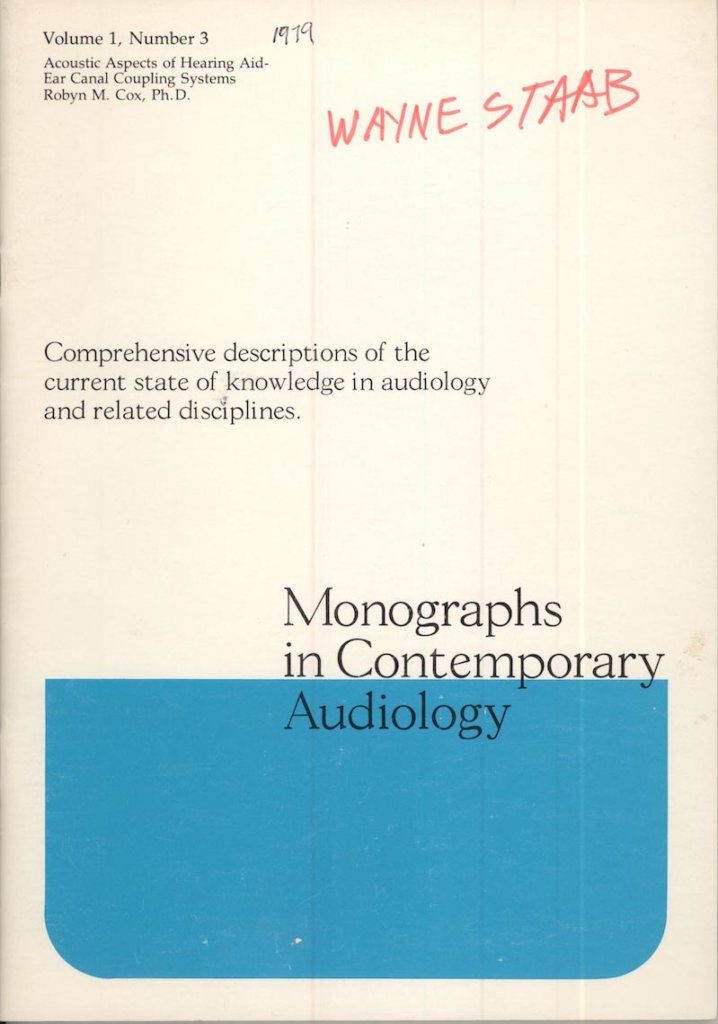Hearing and Hearing Aid Journals – Gone But Not Forgotten
Aside from textbooks, a variety of journals related to hearing, hearing aids, and associated topics have been used by hearing professionals to educate themselves in methods and procedures to better identify and manage hearing loss.
Some publications, once available, are no longer in existence, while others have changed their content and names over time to better reflect the journal’s changing demographics.
This article recalls a few of the periodicals that no longer exist, or if they currently exist, are now available under another name.
The journals are not presented alphabetically, nor in their order of significance. Additionally, images of some of the early journals were no longer in the author’s library, having been discarded a few years ago after no interest in them was expressed.
Hearing Aid
Hearing Aid magazine was among the first of the hearing aid trade journals. The first copy of Hearing Aid, published by Hearing Aid Publishing Co. St. Paul, MN, was mailed in September of 1947. In 1951 the name was changed to The Hearing Dealer, in 1973 to Hearing Instruments, and in 1994 Hearing Review was started, with its staff comprised of several former Hearing Instrument members. Among its first articles in 1947 was the fitting of hearing aids to individuals using otometric principles (Skafte, 1990).
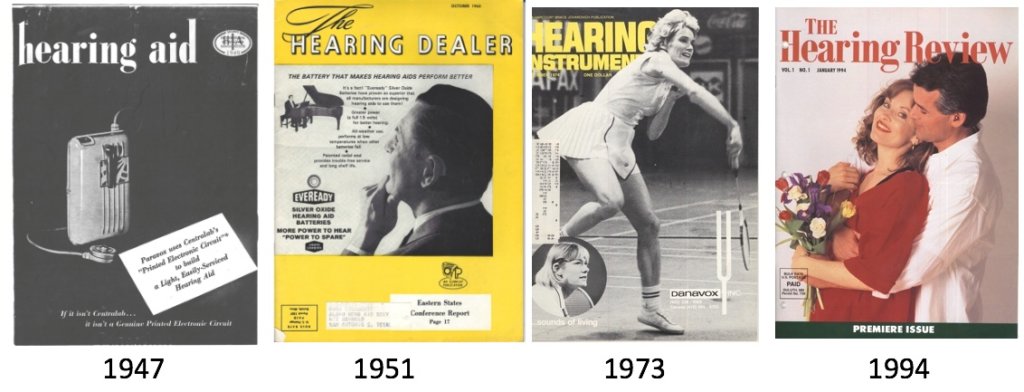
The National Hearing Aid Journal
The National Hearing Aid Journal reportedly published its first issue in July of 1947. This monthly industry trade magazine saw name changes as well and dropped the word National in the 1970s to become The Hearing Aid Journal, and later to The Hearing Journal, under which name it continues to be published. The Hearing Journal is published monthly by Lippincott Williams & Wilkens, New York.

In both of the previously-described journals, Hearing Aid, and The National Hearing Aid Journal, the name changes appear to be made to reflect the changing identification of the industry participants and products.
The Decibel
The Decibel was first published in the United States in October, 1952 by the Society of Hearing Aid Audiologists (SHAA), which later became the National Hearing Aid Society, and more recently, the International Hearing Society. The journal’s name was changed with its second issue, to Audecibel. This quarterly publication was the official journal of the organization. Its purpose was to bring to the otologist, the clinical audiologist, the hearing aid audiologist and others interested in the field of hearing and audiology, authoritative articles, papers and data concerned with research, techniques, education and new developments in the field of treating and assisting the hard of hearing so that mutual and overlapping problems may be recognized and outstanding ideas, skills and experience be shared for the benefit of all.

1960s, 1970s and 1980s
In many ways, in the 1960s, 1970s and 1980s, Audecibel, along with Hearing Instruments and The Hearing Journal (with their subsequent name changes), provided essentially all the practical/use articles related to hearing and hearing aid use. Essentially all of the leading audiologists, hearing aid specialists, and otolaryngologists worldwide published articles in these three trade publications. These were the “how to” and “why is this important?” publications during these decades. They published important information that did not conform to the editorial and or research dictates of other professional journals at that time that related to hearing, both medical and audiological (e.g., The Journal of Speech and Hearing Research, Laryngoscope, etc.).
Hearing Progress
This publication for consumers was published quarterly by the Maico Hearing Foundation, Minneapolis, Minnesota. Until his death in 1960, Maico founder Leland Watson wrote an article in each issue relating to the state of hearing aids and the hearing aid industry. This was in addition to general consumer-focused articles about hearing and its significance, and was dedicated to those with an interest in better hearing. The start date of this publication was June, 1957 and this author’s last file copy was the Winter of 1967. A note in the 1967 issue indicated that this was among the 10 millionth copy of Hearing Progress. A letter from Maico to this author in 1971 indicated that the magazine had been discontinued. Copies were mailed, without cost, through the courtesy of the worldwide network of Maico hearing aid consultants.
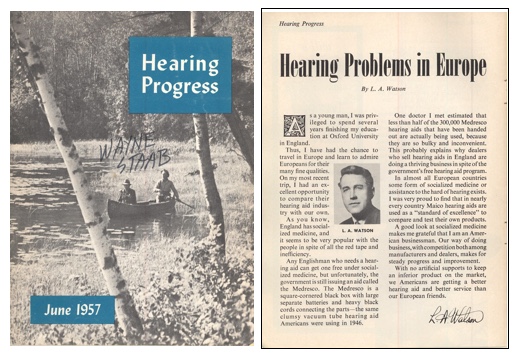
Journal of Auditory Research (JAR)
JAR was an interdiscipline non-profit quarterly for all workers seriously interested in the scientific study of hearing. This publication covered such fields as: otology, audiology, psychoacoustics, musicology, speech & communications, neurophysiology of audition, instrumentation for hearing research, and auditory aspects of human engineering. The original Editorial Policy Board consisted of: J. Donald Harris, Ph.D., (Editor), Norton Canfield, M.D., Raymond Carhart, Ph.D. Stacy Guild, Ph.D., Henry Haines, M.D., Fred Kranz, Ph.D., Alvin Liberman, Ph.D., and E. Glen Wever, Ph.D. Of these, five, along with J. Donald Harris, continued until JAR was discontinued.
J. Donald Harris was the originator and editor of JAR. The journal ran from 1960 to 1986 and introduced many of the foundational studies in the fields of audiology and auditory science. “Because of J.D. Harris’ guidance, JAR was viewed by many as having innovative and thought-provoking articles and commentary. JAR also had a wide-based appeal achieving an excellent balance between clinical and basic science.” (Musiek, 2015)
Recent republishing of some of the articles has been undertaken by Frank Musiek, Ph.D., and presented in the “Pathways” section of Hearing Health and Technology Matters (http://hearinghealthmatters.org/).
JAR was published by The C.W. Shilling Auditory Research Center, Inc., a private non-profit corporation devoted to scholarship, research and publication in the field of hearing, Groton, CT.
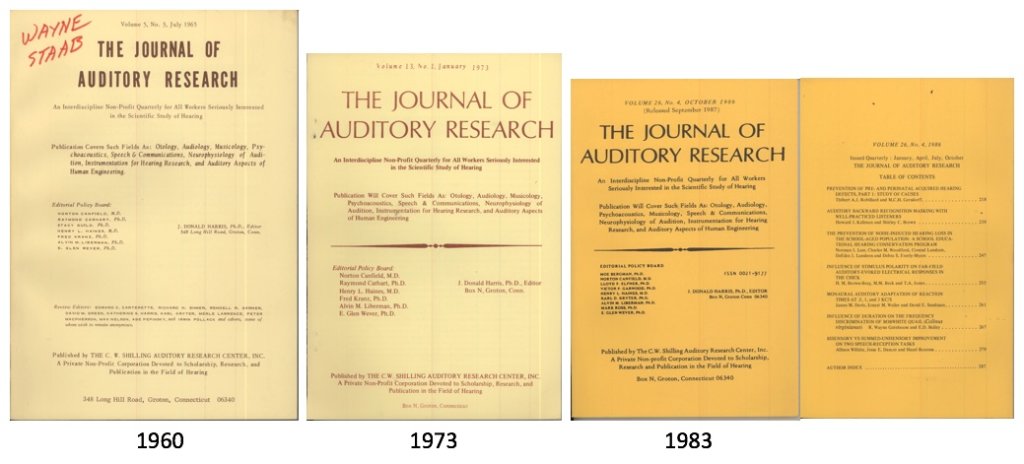
Fenestra
Fenestra was a quarterly review of audiological literature, published by Excerpta Medica Foundation, and printed in the Netherlands by Boosten & Stols, N.V. Maastricht. It was made possible by North American Philips Co. Inc., Hearing Aid Division. It started publication in 1964 and continued at least through Volume 13 in 1976 (the last issue in the author’s collection). Fenestra was edited by E. De Boer. Fenestra published abstracts of selected significant articles, as shown on the page on the right in Figure 6.

The Journal of Audiological Technique
This journal was first published in 1980. The name was changed in 1998 to Audiologische Akustik/Audiological Acoustics. The Journal of Audiological Technique published articles and notes in German and English, side by side. It printed contributions emphasizing audiometry, hearing, hearing disorders and hearing aids, and measuring techniques. The journal was published by Median Verlag. Heidelberg, Germany. The author had no copies of Audiological Acoustics for illustration purposes.
Following its name change, the journal continued to publish articles and notes in German and English, side by side. However, it is now an international open access e-journal and is aimed at anyone who works on and with scientific publications in the field. It publishes original and review articles as well as technical communications and case reports that have gone through a peer review process. In order to achieve international readership, Audiological Acoustics recommends the use of English language. German language is accepted in case of special reasons. The contributions are up-to-date, permanently and free of charge for all interested parties. The journal serves as the official scientific publication organ of the German Society for Audiology.

Translations
The title, Translations of the Beltone Institute for Hearing Research, describes the publication’s purpose. Translations was a series prepared for the benefit of those persons in the United States who were professionally concerned with problems related to hearing, but who were not rapid readers of all the languages in which pertinent and important research was being reported. Translations was distributed without charge to libraries and to interested individuals, and was published by The Beltone Institute for Hearing Research, Chicago, Illinois.
The following persons, who comprised the board of trustees of the Beltone Institute for Hearing Research, served as advisors for the translation series: Raymond Carhart, Ph.D., Joseph Hind Jr., Ph.D., John Lindsay, M.D., S. F. Posen, Chairman, and S. Richard Silverman, Ph.D. The Editor was Juergen Tonndorf, M.D.
Translation No. 1 was published in 1955, and translated as “On Occupational Deafness from White Noise” by Luigi Bernabei (Sulla sordità professionale da rumore bianco, Rivista de Audiologia Practica (Milan) Anno III, Numero 1-2-3, 1953). The last one this author has on record is Translation No. 25, October, 1971, titled “The Temporal Dimension of Audition in Binaural Hearing” by E. Bocca, G. Teatini, and A. Antonelli. This last translation was of “La dimensione temporale della percezione uditiva in udito binauricolare,” Attí della socíetá ítaliana dí Fonetíca Foníatría e Audiología, IX National Congress, Rome, April 8-9, 1967.
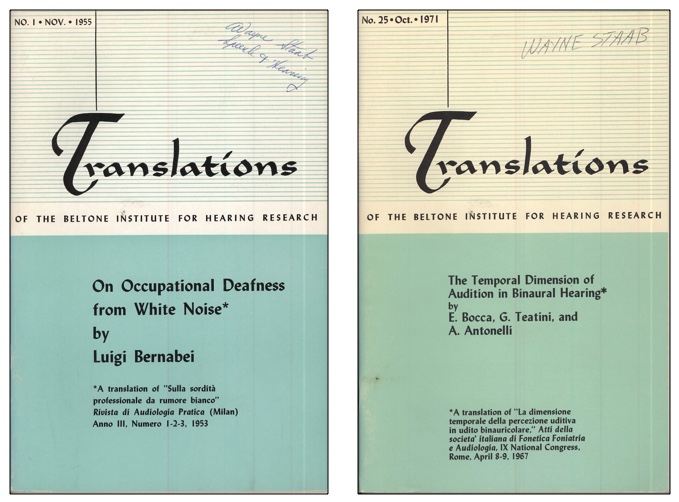
Maico Audiological Library Series
From 1962 through 1972, Maico Hearing Instruments published a series of invited reports by experts in the hearing field on various topics. Numerous Reports were included in each volume. Volumes ranged from 1 through 10. The Reports in each volume were for the benefit of those serving the hard of hearing in private practice or clinical evaluation and covered a variety of topics. As an example, Volume 1 included 13 Reports, with authors ranging from Philip Rosenberg, Ph.D. (Report No. 1, Pure Tone Audiometry), to Alan Feldman, Ph.D. (Report #13, Speech Audiometry). This author’s last Volume 10 contained 10 Reports, with authors ranging from Marion Downs, M.A. (Report No 1, Maintaining Children’s Hearing Aids: The Role of the Parents), to Larry Bradford, Ph.D., Denis Newman, M.S., Wade Robinett, M.D. (Report No. 10, Audiological-Otological Follow-up in Hearing Conservation).
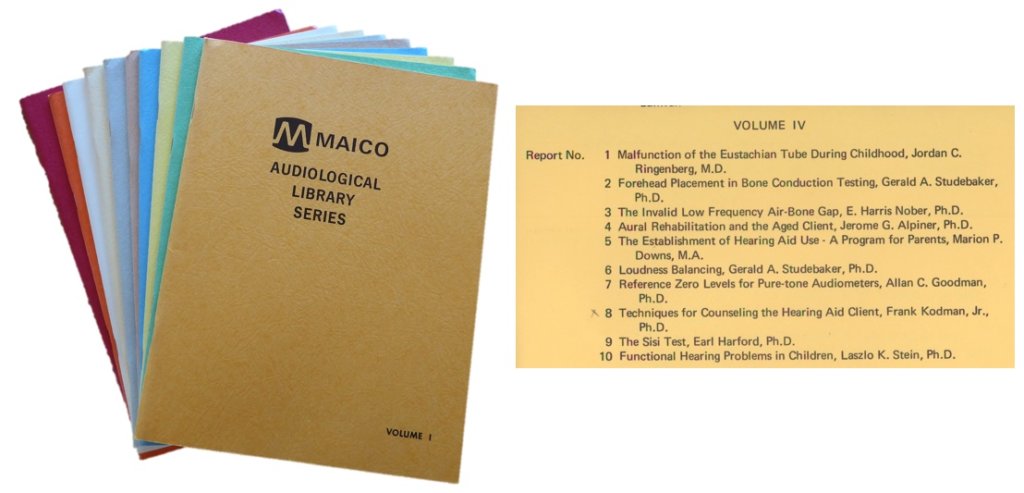
International Audiology
This journal was first published as the official organ of the International Society of Audiology, and under this title from 1962 through 1970. From 1971 through 2001 it was called Audiology: Journal of Auditory Communication. In 2002 its name was changed to the International Journal of Audiology after a merger with the British Journal of Audiology and Scandinavian Audiology journals. It serves as the official journal of the British Society of Audiology, the International Society of Audiology, and the Nordic Audiological Society. It is published by Taylor & Francis, United Kingdom.
The International Journal of Audiology is a peer-reviewed medical journal covering research in audiology, including psychoacoustics, anatomy, physiology, cellular and molecular biology, genetics, neuroscience, speech and hearing sciences and rehabilitation devices.
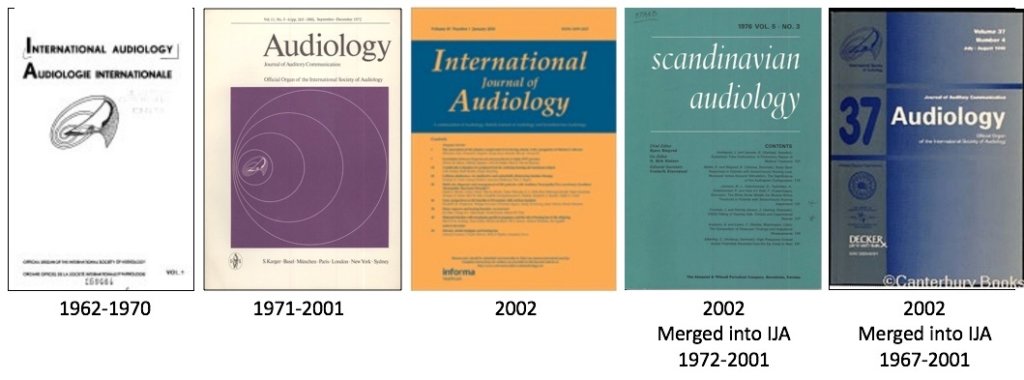
Journal of the American Audiology Society
With Volume 1, July-August 1975, Issue 1, the Journal of the American Audiology Society (JAAS) was the official journal of the American Audiology Society, with a name change to Ear and Hearing in 1980. JAAS was published bimonthly, one volume per year, and printed by The Williams & Wilkins Company, Baltimore, Maryland. Although the name of the organization was changed to the American Auditory Society in 1975, the journal maintained the name Journal of the American Audiology Society until changed to Ear and Hearing in 1980. The journal covers all aspects of auditory and vestibular disorders from the basic science of hearing and balance disorders to auditory electrophysiology to amplification and the psychological factors of hearing loss. This multidisciplinary journal serves the diverse interest of all members of the hearing professional community.

ASHA Monographs
ASHA Monographs were published from 1950 to 1993. These issues were scholarly treatises that dealt with experimental, clinical, theoretical, tutorial, or historical matters pertaining to the normal processes and disorders of human communication. In 1994 ASHA's Publications Board ceased publication of Monographs in favor of publishing such materials as supplements to the four ASHA scholarly journals. A total of 30 ASHA Monographs were published, starting with Monograph Supplement 1: The Effects of Noise on Man (1950), and ending with Number 30: Language Interaction in Clinical and Educational Settings (1993). Eleven of the Monographs related to hearing: Monographs Nos. 1, 3, 9, 11, 12, 13, 15, 19, 23, 24, 28. The first eleven Monographs were identified as Monograph Supplements, whereas from 12 through 30, they were identified specifically as ASHA Monographs. These are available as free .pdf downloads from https://www.asha.org/publications/monographs/.
ASHA Reports
ASHA Reports were published from 1965 to 1991. These issues contained proceedings of conferences, workshops, and seminars that dealt with the normal processes and disorders of human communication. In 1993, ASHA's Publications Board ceased publication of Reports in favor of publishing such materials as supplements to any of the four ASHA scholarly journals. Twenty-one Reports were published, with six relating to hearing. These are available as free .pdf downloads from https://www.asha.org/publications/reports/.
Other Technology Reports
A variety of more non-traditional sources (Reports) provided research relating to hearing, with many coming from the U.S. Military. The images of sources in Figure 14 represent selected copies of hearing topics from those publications. Much of the research is via contracts with major universities, but published in the military branch Reports.
Monographs in Contemporary Audiology
This publication was intended to be published quarterly by the Educational Publications Division of Maico Hearing Instruments, Minneapolis, MN. The first issues were funded by Maico, but the later issues were funded by a special instruments dealer, (John Ciarrocca). The monograph was described to include comprehensive descriptions of the current state of audiology and related disciplines by many of the leading audiologists of the day. Cy Libby, the father of the Libby Horn, took on the role of editor and publisher. The Monographs were published from 1978 until 1983. V1 #1 was Sept, 1978, Jerger, Hayes, et al. #2, Nov 1978, Northern; #3, March, 1979, Cox; #4, Mau, 1979, Harford; v 2,#1, January, 1980,Joe Barry; #2 missing; #3, Humes and Konkle; May, 1980; #4, Dec, 1980, Norlin and Van Tasell; V3, #1, Nov, 1981, M Miller; #2, Feb, 1982, Diefendorf; #3, Oct 1982, Fitzgerald and Bess; #4, Nov 1982, Berger and Hagberg; Vol 4, #1, Jan, 1983, Denis Byrne; #2, May, 1983, Musiek (Curran, 2019).
Monographs in Contemporary Audiology also published the Vanderbilt Hearing-Aid Report in 1982 and was edited by Gerald a. Studebaker and Fred H. Bess. (Cy Libby recently passed away at age 98. See article on him in this issue’s Industry News)
Other Journals
This is not a complete list of journals that have been terminated for various reasons, but is a good start for those that were most visible. A few of the others not listed here include:
- Bulletin of Prosthetics Research, published by the Veteran’s Administration
- Audiology Acoustics
- Audiology and Hearing Education
- Advance for Audiologists (Merion Publications)
- Journal of Rehabilitative Audiology
- And others, I am certain that have been left off this list. To them, I apologize.
An Addendum of Names by Karl Strom, Editor of Hearing Review.
Editor’s Note: I had asked Karl Strom, who is the longtime editor of Hearing Review and has been on the editorial side of things since the days of Hearing Instruments, for any insight that he may have. While Dr. Wayne Staab has provided us with a few long-forgotten magazines and journals in our field, Karl Strom provides some historic insight into long-forgotten names from the editorial side of our field.
Marshall Reinig, who started Ojibway Press and the journal Hearing Aid in the 1950s, hired Robert (Bob) Edgell as one of the Hearing Dealer’s first editors. Edgell was a talented writer and an even better “schmoozer,” and was instrumental in helping start what would eventually become the Hearing Industries Association (HIA).
Reinig also hired a young former CIA translator and computer punch-card wiz for his new state-of-the-art circulation department. His name was Lars Fladmark. Eventually Fladmark would assume Reinig’s responsibilities and even purchase Reinig’s home… a property that is only a few acres away from my family’s original homestead on the North Shore of Lake Superior!
Harcourt Brace-Harvest Books (later renamed HBJ after William Jovanovich gained a controlling interest) purchased Ojibway Press and made Fladmark its executive VP and Edgell the director and vice-chairman. HBJ was very successful (even owning Sea World) but became the target of a devastating hostile take-over by British publisher Robert Maxwell. HBJ was forced to sell off over $370 million of its assets. To give you some sense of scale, HBJ had earnings of $38 million on sales of $278 million in 1986. The leveraged buyout is still taught as a case study at the Wharton School of Business to demonstrate how detrimental these can be for everyone but the financiers.
Edgell emerged from the late-80s with part of the publishing arm of HBJ which he named Edgell Communications—as well as ton of debt and mixed feelings from some former colleagues. Edgell Communications included Hearing Instruments, and I worked as an associate editor on one of its smaller magazines, Paper Sales. Mr. Edgell ended his life by jumping off his high-rise balcony in Florida, but he exited as a publishing legend. The company was then sold and became AdvanceStar.
Fladmark, who had for years hosted BHI’s “Run for Better Hearing” in conjunction with Grandma’s Marathon in Duluth, Minn, was encouraged by many people to start The Hearing Review, which he did and was the founder and CEO until he sold it in June 2000.
References
- Musiek, F. (2015). https://hearinghealthmatters.org/pathways/2015/revisiting-the-journal-of-auditory-research-jar/
- Skafte, M. (1990). 50 years of hearing health care, 1940-1990. Hearing Instruments, Sept. 1990, Vol. 41, No. 9, Published by Edgell Communications, Inc., Duluth, MN.
- Curran, J. (2019). Personal communication.
- Staab, W. (2020). Personal library.






